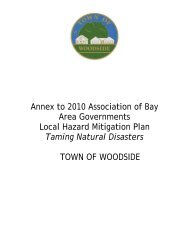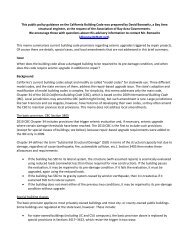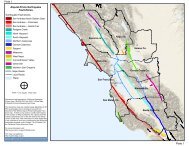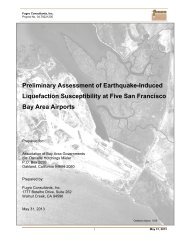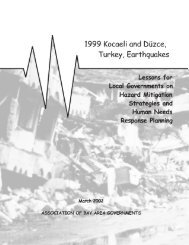Safe Enough to Stay - ABAG Earthquake and Hazards Program
Safe Enough to Stay - ABAG Earthquake and Hazards Program
Safe Enough to Stay - ABAG Earthquake and Hazards Program
- No tags were found...
You also want an ePaper? Increase the reach of your titles
YUMPU automatically turns print PDFs into web optimized ePapers that Google loves.
<strong>Safe</strong> <strong>Enough</strong> <strong>to</strong> <strong>Stay</strong>immediate post-earthquake period but required as normalcy isrecovered. A recent report published by the Structural EngineersAssociation of Northern California has proposed a way <strong>to</strong> link ASCE31 criteria <strong>to</strong> recovery time. 43 We recommend applying its principlesin coordination with the SPUR-proposed habitability timeline.For example, SPUR’s proposed shelter-in-place st<strong>and</strong>ards call forweather protection provided by exterior windows <strong>to</strong> be res<strong>to</strong>red withinseven days of the emergency declaration. In ASCE 31 terms, weatherprotection from windows is addressed implicitly with criteria related<strong>to</strong> glazing or, in some window wall systems, cladding. The StructuralEngineers Association of Northern California report puts glazing inthe category of components expected <strong>to</strong> be repairable within days or,for extensive damage <strong>to</strong> a large building, weeks. With a seven-daytarget, a typical building would be able <strong>to</strong> meet the shelter-in-placest<strong>and</strong>ard even if the earthquake did cause glazing damage. Therefore,the evaluation criteria need not consider ASCE 31’s provisions forglazing. In a larger building, or where potential glazing damage wouldnot be repairable in seven days, the glazing details would need <strong>to</strong> bechecked.Another example: SPUR’s st<strong>and</strong>ards call for gas <strong>and</strong> electricityservice <strong>to</strong> be res<strong>to</strong>red within each unit within 30 days of service <strong>to</strong>the building being res<strong>to</strong>red by PG&E. ASCE 31 addresses a varietyof related items, from equipment attachment <strong>to</strong> flexible couplingsin hazardous materials piping. Where the Structural EngineersAssociation of Northern California report indicates that repairs wouldtake weeks, the issue would be moot relative <strong>to</strong> the 30-day target.Where the anticipated repair would take months, the conditionrepresents a potential deficiency <strong>and</strong> must be checked.Vetting the ASCE 31 criteria in this way is challenging in part becauseresidential structure types range from wood or masonry houses <strong>to</strong>designated his<strong>to</strong>ric apartment buildings <strong>to</strong> concrete or steel highrises.In larger buildings, nonstructural functions are often served byspecialized components. In smaller vernacular buildings, structuralelements such as wood-sheathed roofs or stucco walls also affectsecurity, weather tightness, fire safety, etc., so structural damagethat’s acceptable under shelter-in-place guidelines might still affectshelter-in-place capacity.D. Contents deficienciesContents deficiencies are those related <strong>to</strong> such items as furniture,items s<strong>to</strong>red on shelves, <strong>and</strong> certain equipment. While contentsdamage can impact functional recovery of certain occupancies<strong>and</strong> full recovery of most occupancies, 44 shelter-in-place impactsin typical residential occupancies are expected <strong>to</strong> be rare. Onlyhazardous materials contents (improperly s<strong>to</strong>red solvents, forexample) might delay reoccupancy in a typical house or smallapartment building. In large residential buildings (with industrialkitchens or central plants, for example) or in mixed-use buildings,other specialty contents might pose shelter-in-place risks.Therefore, we recommend waiving all contents provisions of ASCE 31except for those related <strong>to</strong> s<strong>to</strong>red hazardous materials. A proceduralprovision should be used <strong>to</strong> invoke supplemental criteria subject <strong>to</strong>code official approval for cases of mixed occupancy.E. Utilities infrastructure deficienciesUtilities infrastructure deficiencies are those related <strong>to</strong> servicesprovided from outside the building, such as water, gas, electricity,sewage removal <strong>and</strong> telecommunications. The shelter-in-placecapacity of a given residential building can be impacted by theperformance of utility services. SPUR’s proposed shelter-in-placest<strong>and</strong>ards will generally waive requirements for utilities within a unit(water, gas, electricity, sewer) while service <strong>to</strong> the building is down.Still, it will be useful for planning purposes <strong>to</strong> have some estimate ofthe number <strong>and</strong> location of the residential units most likely <strong>to</strong> loseservices for extended periods.It is impractical <strong>to</strong> require the evalua<strong>to</strong>r of a single residential building<strong>to</strong> study <strong>and</strong> draw conclusions about the recoverability of lifelines.Our proposed solution is for the city <strong>and</strong> service providers <strong>to</strong> developrough maps sufficient <strong>to</strong> allow broad relative statements abou<strong>to</strong>utages on a neighborhood basis. Presumably, these would be basedon considerations such as the presence of brittle piping in liquefiablesoil, existing plans <strong>and</strong> prioritizations, etc. Therefore, we recommendthat assessment of shelter-in-place deficiency relative <strong>to</strong> utilities bebased on maps or inven<strong>to</strong>ries of vulnerable infrastructure producedby service providers, by the city or by the San Francisco LifelinesCouncil.In some cases, alternative services can be provided on a timely <strong>and</strong>temporary basis while normal service is being res<strong>to</strong>red. To the extentthat such provisions can be reliably predicted or planned for, shelterin-placeevaluation criteria should allow for these as alternativemeans of compliance.Application <strong>to</strong> special residential occupanciesSPUR’s proposed shelter-in-place st<strong>and</strong>ards do not apply directly <strong>to</strong>certain residential occupancies providing assisted living <strong>and</strong> similarservices. Even for normal residential occupancies, however, someresidents are likely <strong>to</strong> have disabilities that require accommodationssuch as ramps, eleva<strong>to</strong>rs, strobe alarms, etc. For these conditions, werecommend the development of supplemental criteria in coordinationwith the Mayor’s Office on Disability.43 Bonowitz, D., “Resilience Criteria for Seismic Evaluation of ExistingBuildings,” (Structural Engineers Association of Northern California August 5,2011) www.seaonc.org/pdfs/SEAONC_SPI_Resilience_110805.pdf44 Ibid.SPUR Report > January 2012 41




